- Table of Contents - Previous - Next -
Annex 4
Canada’s Financial Performance in an International Context
Introduction
- This annex compares Canada’s financial position with that of the other Group of Seven (G7) countries (United States, United Kingdom, France, Germany, Japan and Italy).
- Two important factors need to be taken into account in making international comparisons: differences in accounting methods among countries, which affect the comparability of data, and differences in financial responsibilities among levels of government within countries.
- For these reasons, the standardized System of National Accounts definitions and data are used, and the focus is the total government sector rather than distinguishing between the national and subnational level. These data are fairly uniform among countries, and hence are used for international comparisons. The Organisation for Economic Co-operation and Development (OECD) produces a complete series of estimates based on this system. The data presented in this annex are based on the December 2002 OECD Economic Outlook and, as such, do not include any data revisions since then. On this basis:
- Canada has had the largest improvement in its budgetary situation among the G7 countries over the last decade. In 2002 Canada was the only G7 country to record a surplus.
- Canada has achieved the sharpest decline in the debt burden among the G7 countries since the mid-1990s. In 2002 Canada’s debt burden declined to 41.1 per cent of gross domestic product (GDP), below the G7 average. This year only the UK and the U.S. are expected to have lower debt burdens than Canada.
- Financial comparisons at the federal government level between Canada and the United States also require caution, given differences in accounting practices and the treatment of public sector pension funds. The most appropriate way to compare the federal financial situation of the two countries is to use a cash basis of accounting. On this basis:
- The Canadian federal government posted a surplus of 0.4 per cent of GDP in 2001–02, whereas the U.S. federal government ran a deficit of 1.5 per cent of GDP.
- The difference between the federal market debt-to-GDP ratios in Canada and the U.S. has been nearly halved since 1999–2000, to 6.2 percentage points in 2001–02.
Canada was the only G7 country to record a surplus in 2002
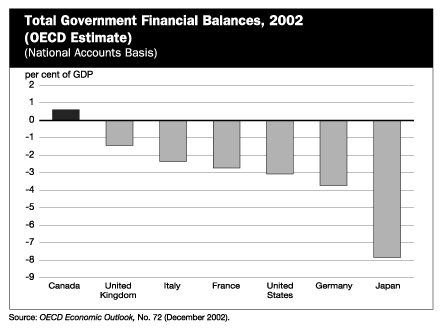
- Canada was the only G7 country to record a surplus in 2002, according to OECD estimates of Canada’s total government sector financial position.[1]
Canada’s financial balance has shown the most improvement of all G7 countries
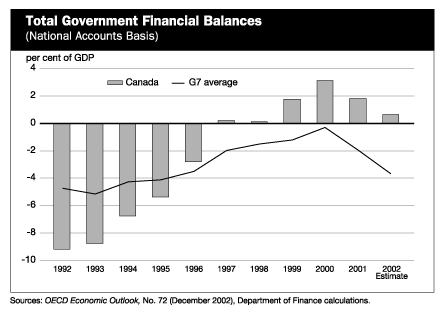
- Canada’s total government sector financial balance has improved substantially over the last decade. The total government deficit peaked at 9.1 per cent of GDP in 1992, which was almost double the G7 average deficit-to-GDP ratio that year.
- By 1997, however, fiscal improvements at all levels of government enabled Canada’s total government sector to post a surplus. Canada has recorded six consecutive surpluses since that time.
- In 2002 Canada recorded a surplus estimated at 0.6 per cent of GDP, compared to an average deficit of 3.7 per cent in the G7 countries. Canada was the only G7 country to record a surplus in 2002, according to OECD estimates.
Canada is the only G7 country to maintain a financial surplus despite the global slowdown

- Canada made the greatest fiscal improvement of the G7 countries from 1992 to 2002. In 1992 Canada had the second highest deficit of the G7 countries in relation to GDP.
- All of the G7 countries have experienced pressure on government finances over the past couple of years, largely due to the global economic slowdown. However, according to OECD estimates, Canada was the only G7 country to record a surplus in 2002.
Canada’s program spending as a share of GDP is now below the G7 average
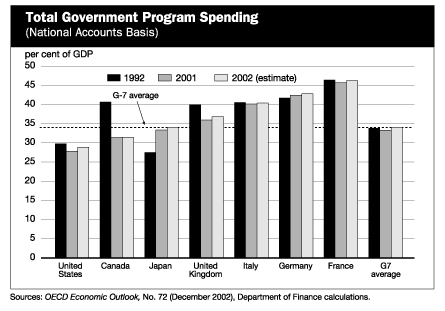
- The rapid turnaround in Canada’s financial position, as a percentage of GDP, is attributable in large part to a sharp reduction in program spending, that is, all expenditures less gross debt charges.
- Between 1992 and 2002, Canada’s total government program spending as a share of GDP was reduced by 9.1 percentage points, a far greater reduction than in any other G7 country.
- As a result, Canada’s program spending relative to GDP is now below the G7 average, whereas in 1992 it was well above the G7 average.
- In fact, in 2002 Canada’s program spending, as a percentage of GDP, was lower than in all other G7 countries except the U.S.
Canada has achieved the largest decline in the debt burden among the G7 countries
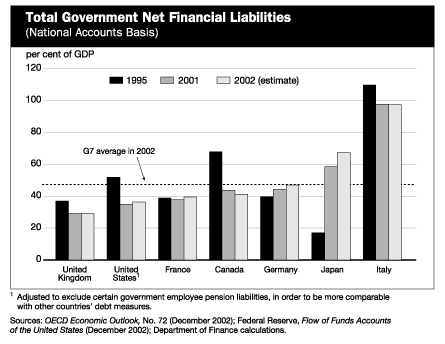
- Since the mid-1990s Canada’s total government sector has achieved the largest decline in its debt burden of all the G7 countries. Between 1995 and 2002 the net debt-to-GDP ratio was reduced by 26.8 percentage points.
- As a result, Canada’s total government debt burden moved below the G7 average in 2001, and only the UK and the U.S. are expected to have lower debt burdens than Canada in 2003.
- Based on OECD projections of continuing fiscal surpluses in Canada and large deficits in the U.S., Canadian and U.S. total government debt burdens are expected to converge by 2004.
Canada–United States Federal Comparisons
- This section compares the financial situation of the Canadian federal government with that of the U.S. federal government.
- In making such comparisons, it is important to note that there are fundamental differences in the accounting practices and responsibilities of the Canadian and U.S. federal governments. For example, in the U.S. the Social Security system, which is the equivalent of the Canada Pension Plan (CPP) and Quebec Pension Plan (QPP), is considered part of the federal sector, whereas in Canada the CPP and QPP are not part of the federal government sector. As a result, U.S. federal financial balance and market debt figures reflect the substantial surpluses in the Social Security system, whereas such surpluses are not included in Canadian federal figures.
- However, a reasonable comparison of the two countries’ fiscal situations can be made using the financial requirements/source of the Canadian federal government (rather than the budgetary balance) and the U.S. federal unified budget balance. This primarily compares the financial situation in both countries on a cash basis of accounting.
- On this basis, the Canadian federal government posted a surplus of 0.4 per cent of GDP in 2001–02. By contrast, the U.S. federal government moved into a deficit position in 2001–02, recording a deficit of 1.5 per cent of GDP. In 2002–03 the Canadian federal government is forecast to have a slight surplus, while the U.S. federal deficit is expected to increase to 2.8 per cent of GDP.
- Similarly, Canadian federal market debt (rather than federal debt or the accumulated deficit) is the most appropriate measure of debt to be compared with U.S. federal debt held by the public. As a result of continued surpluses at the federal level in Canada and the recent deterioration in U.S. federal finances, the difference between the federal market debt-to-GDP ratios in Canada and the U.S. has been nearly halved since 1999–2000, to 6.2 percentage points in 2001–02. In 2002–03 Canadian federal market debt is expected to decline to 38.8 per cent of GDP, while U.S. federal debt held by the public is forecast to rise to 36.1 per cent of GDP, further narrowing the gap to 2.7 percentage points.
While Canada has maintained a financial surplus since 1996–97, the U.S. fell back into deficit in 2001–02

- Both countries achieved a significant turnaround in the financial balance over the last decade, moving from large deficits in the first half of the 1990s to a surplus position in the latter half of the 1990s. The Canadian federal government achieved a financial surplus in 1996–97, one year earlier than the U.S. federal government.
- The Canadian federal government has maintained a financial surplus since that time, posting a surplus of 0.4 per cent of GDP in 2001–02 despite the economic slowdown. By contrast, the U.S. federal fiscal situation has deteriorated markedly: the U.S. returned to a deficit position in 2001–02, recording a deficit of 1.5 per cent of GDP.
- Moreover, the Canadian federal government is expected to record a balanced budget or better in 2002–03, while the U.S. federal deficit is expected to increase to 2.8 per cent of GDP.
The difference between federal market debt-to-GDP ratios in Canada and the U.S. has been nearly halved over the past two years
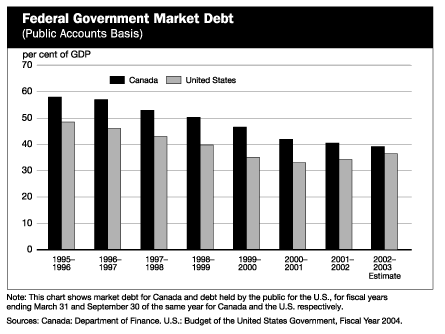
- For debt comparisons, the appropriate measures are market debt for Canada and publicly held debt for the U.S.
- Both countries have achieved a significant decline in the debt-to-GDP ratio since the mid-1990s. Moreover, due to continued surpluses at the federal level in Canada and the deterioration in U.S. federal finances, the difference between the federal market debt-to-GDP ratios in the two countries has been nearly halved since 1999–2000, to 6.2 percentage points in 2001–02.
- In 2002–03 Canadian federal market debt is expected to decline to 38.8 per cent of GDP, while U.S. federal debt held by the public is forecast to rise to 36.1 per cent of GDP, further narrowing the gap to 2.7 percentage points.
1 Measured on a National Accounts basis (the measure commonly used to make comparisons between countries). Includes federal, provincial-territorial and local governments as well as the Canada Pension Plan and Quebec Pension Plan. [return]
- Table of Contents - Previous - Next -
| Last Updated: 2003-02-18 |
| ||||